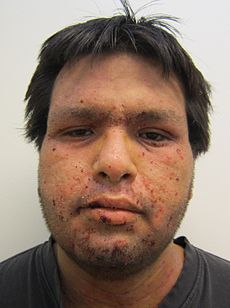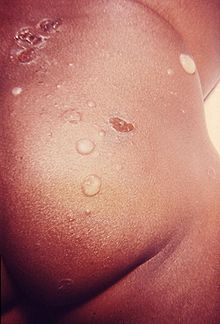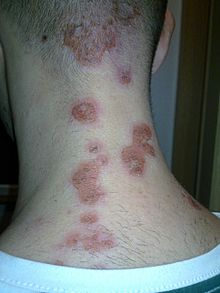- Impetigo
-
Impetigo Classification and external resources 
A severe case of impetigoICD-10 L01 ICD-9 684 DiseasesDB 6753 MedlinePlus 000860 eMedicine derm/195 emerg/283 med/1163 ped/1172 MeSH D007169 Impetigo /ɪmpɨˈtaɪɡoʊ/ is a highly contagious bacterial skin infection most common among pre-school children.[1] People who play close contact sports such as rugby, American football and wrestling are also susceptible, regardless of age. Impetigo is not as common in adults. The name derives from the Latin impetere ("assail"). It is also known as school sores.[2]
Contents
Classification
Bullous impetigo
Bullous impetigo primarily affects infants and children younger than 2 years. It causes painless, fluid-filled blisters — usually on the trunk, arms and legs. The skin around the blister is usually red and itchy but not sore. The blisters, which break and scab over with a yellow-colored crust, may be large or small, and may last longer than sores from other types of impetigo.
Ecthyma
Ecthyma is a more serious form of impetigo in which the infection penetrates deeper into the skin's second layer, the dermis. Signs and symptoms include:
- Painful fluid- or pus-filled sores that turn into deep ulcers, usually on the legs and feet
- A hard, thick, gray-yellow crust covering the sores
- Swollen lymph glands in the affected area
- Little holes the size of pinheads to the size of pennies appear after crust recedes
- Scars that remain after the ulcers heal
Causes
It is primarily caused by Staphylococcus aureus, and sometimes by Streptococcus pyogenes.[3] According to the American Academy of Family Physicians, both bullous and nonbullous are primarily caused by Staphylococcus aureus, with Streptococcus also commonly being involved in the nonbullous form."[4]
Transmission
The infection is spread by direct contact with lesions or with nasal carriers. The incubation period is 1–3 days. Dried streptococci in the air are not infectious to intact skin. Scratching may spread the lesions.
Diagnosis
Impetigo generally appears as honey-colored scabs formed from dried serum, and is often found on the arms, legs, or face.[3]
Prevention
Good hygiene practices can help prevent impetigo from spreading. Those who are infected should use soap and water to clean their skin and take baths or showers regularly. Non-infected members of the household should pay special attention to areas of the skin that have been injured, such as cuts, scrapes, insect bites, areas of eczema, and rashes. These areas should be kept clean and covered to prevent infection. In addition, anyone with impetigo should cover the impetigo sores with gauze and tape. All members of the household should wash their hands thoroughly with soap regularly. It is also a good idea for everyone to keep their fingernails cut short to make hand washing more effective. Contact with the infected person and his or her belongings should be avoided, and the infected person should use separate towels for bathing and hand washing. If necessary, paper towels can be used in place of cloth towels for hand drying. The infected person's bed linens, towels, and clothing should be separated from those of other family members, as well. When a person has impetigo, it is common for them to get it a second time in the space of 6–9 months. This usually occurs in people aged 12–16.
Treatment
For generations, the disease was treated with an application of the antiseptic gentian violet.[5] Today, topical or oral antibiotics are usually prescribed. Treatment may involve washing with soap and water and letting the impetigo dry in the air. Mild cases may be treated with bactericidal ointment, such as fusidic acid, mupirocin, chloramphenicol or neosporin, which in some countries may be available over-the-counter. More severe cases require oral antibiotics, such as dicloxacillin, flucloxacillin or erythromycin. Alternatively amoxicillin combined with clavulanate potassium, cephalosporins (1st generation) and many others may also be used as an antibiotic treatment.
References
- Notes
- ^ NHS Impetigo
- ^ Impetigo — school sores — Better Health Channel
- ^ a b Kumar, Vinay; Abbas, Abul K.; Fausto, Nelson; & Mitchell, Richard N. (2007). Robbins Basic Pathology (8th ed.). Saunders Elsevier. pp. 843 ISBN 978-1-4160-2973-1
- ^ Stulberg DL, Penrod MA, Blatny RA (2002). "Common bacterial skin infections.". American Family Physician 66 (1): 119–24. PMID 12126026. http://www.aafp.org/afp/20020701/119.html.
- ^ MacDonald RS (October 2004). "Treatment of impetigo: Paint it blue". BMJ 329 (7472): 979. doi:10.1136/bmj.329.7472.979. PMC 524121. PMID 15499130. http://www.bmj.com/cgi/content/full/329/7472/979.
External links
- Impetigo Pictures — Pictures of Impetigo caused by Staph Infections and MRSA.
- NIH/Medline
- Photo (University of Iowa)
- Dermnet NZ
- Impetigo and Ecthyma at Merck Manual of Diagnosis and Therapy Professional Edition
Infectious skin disease: Bacterial skin disease (L00–L08, 680–686) Gram + Staphylococcus (Staphylococcal scalded skin syndrome, Impetigo, Toxic shock syndrome) · Streptococcus (Impetigo, Cutaneous group B streptococcal infection, Streptococcal intertrigo, Cutaneous Streptococcus iniae infection, Erysipelas/Chronic recurrent erysipelas, Scarlet fever) · Corynebacterium (Erythrasma)Mycobacterium-related: Aquarium granuloma · Borderline lepromatous leprosy · Borderline leprosy · Borderline tuberculoid leprosy · Buruli ulcer · Erythema induratum · Histoid leprosy · Lepromatous leprosy · Leprosy · Lichen scrofulosorum · Lupus vulgaris · Miliary tuberculosis · Mycobacterium avium-intracellulare complex infection · Mycobacterium haemophilum infection · Mycobacterium kansasii infection · Papulonecrotic tuberculid · Primary inoculation tuberculosis · Rapid growing mycobacterium infection · Scrofuloderma · Tuberculosis cutis orificialis · Tuberculosis verrucosa cutis · Tuberculous cellulitis · Tuberculous gumma · Tuberculoid leprosyCutaneous actinomycosis · Nocardiosis · Cutaneous diphtheria infection · Arcanobacterium haemolyticum infection · Group JK corynebacterium sepsisGram - α: Endemic typhus · Epidemic typhus · Scrub typhus · North Asian tick typhus · Queensland tick typhus · Flying squirrel typhus · Trench fever · Bacillary angiomatosis · African tick bite fever · American tick bite fever · Rickettsia aeschlimannii infection · Rickettsialpox · Rocky Mountain spotted fever · Human granulocytotropic anaplasmosis · Human monocytotropic ehrlichiosis · Flea-borne spotted fever · Japanese spotted fever · Mediterranean spotted fever · Flinders Island spotted fever · Verruga peruana · Brill–Zinsser disease · Brucellosis · Cat scratch disease · Oroya fever · Ehrlichiosis ewingii infectionβ: Gonococcemia/Gonorrhea/Primary gonococcal dermatitis · Melioidosis · Cutaneous Pasteurella hemolytica infection · Meningococcemia · Glanders · Chromobacteriosis infectionγ: Pasteurellosis · Tularemia · Vibrio vulnificus infection · Rhinoscleroma · Haemophilus influenzae cellulitis · Pseudomonal pyoderma/Pseudomonas hot-foot syndrome/Hot tub folliculitis/Ecthyma gangrenosum/Green nail syndrome · Q fever · Salmonellosis · Shigellosis · Plague · Granuloma inguinale · Chancroid · Aeromonas infectionε: Helicobacter cellulitisOtherSyphilid · Syphilis · Chancre · Yaws · Pinta · Bejel · Chlamydial infection · Leptospirosis · Rat-bite fever · Lyme disease · Lymphogranuloma venereum ·Unspecified
pathogenAbscess (Periapical abscess) · Boil/furuncle (Hospital furunculosis) · Carbuncle · Cellulitis (Paronychia/Pyogenic paronychia, Perianal cellulitis) · Acute lymphadenitis · Pilonidal cyst · PyodermaFolliculitis (Superficial pustular folliculitis, Sycosis vulgaris) · Pimple · Ecthyma · Pitted keratolysis · Trichomycosis axillaris · Necrotizing fascitis · Gangrene (Chronic undermining burrowing ulcers, Fournier gangrene) · Elephantiasis nostras · Blistering distal dactylitis · Botryomycosis · Malakoplakia · Gram-negative folliculitis · Gram-negative toe web infection · Pyomyositis · Blastomycosis-like pyoderma · Bullous impetigo · Chronic lymphangitis · Recurrent toxin-mediated perineal erythema · Tick-borne lymphadenopathy · Tropical ulcer ·Categories:- Bacterium-related cutaneous conditions
Wikimedia Foundation. 2010.


